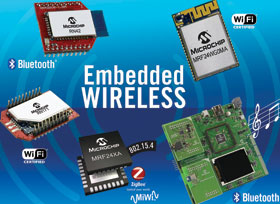

Microchip announced a major expansion of its embedded wireless portfolio. New Bluetooth additions include the PIC32 Bluetooth Audio Development Kit, featuring modules, stacks and CODECs, and XBee footprint-compatible socket modules with integrated stacks.
The new Wi-Fi offerings comprise IEEE 802.11b/g Wi-Fi modules with Microchip’s free source-code TCP/IP stack running on a PIC microcontroller, as well as XBee footprint-compatible socket modules with integrated stacks for ease of use.
Microchip is also adding a low-power 2,4 GHz radio that supports, in one chip, both the IEEE 802.15.4 and proprietary data rates (from 125 Kbps to 2 Mbps), including the ZigBee, MiWi and other proprietary protocols.
There are many wireless network designs that need to operate with very low power consumption. Examples include battery-powered home and industrial automation wireless-sensor mesh networks, as well as ZigBee RF4CE-standard-based remote controls. The 2,4 GHz IEEE 802.15.4 MRF24XA transceiver radio provides a very low operating voltage range of 1,5 to 3,6 V and receive power consumption of only 13 mA, which enables years of battery life.
Some designers want an easy way to migrate their 802.15.4 designs to either Wi-Fi or Bluetooth, in order to make them accessible from smartphones and tablets, or to add Internet connectivity. This includes applications such as wireless sensor networks, remote monitoring/control and measurement, and M2M cable replacements for home, commercial and industrial networks.
The RN XV series of Wi-Fi and Bluetooth socket modules provide agency-certified, drop-in connectivity for any XBee socket. To simplify designs, the stacks are integrated on the module, configured via simple ASCII commands, and can easily connect to any MCU via a serial interface.
Other designers want to add more extensible Wi-Fi functionality, such as a complete Web server and e-mail, via a configurable source-code TCP/IP stack that is resident on one of many PIC microcontrollers. The new low-power and agency-certified MRF24WG0MA/MB modules connect at all IEEE 802.11b/g data rates, up to 54 Mbps, and are Microchip’s first to support a sustained throughput of 5 Mbps. This provides a footprint-compatible migration path for users of Microchip’s existing Wi-Fi modules who need greater speed or increased access-point compatibility, in addition to more features.
Bluetooth digital audio is rapidly expanding in high-volume applications such as accessories for smartphones and tablets, as well as audio sound bars. To meet this demand, the new PIC32 Bluetooth Audio Development Kit builds on Microchip’s existing stack-integrated Bluetooth audio module with a new low-cost, agency-certified Bluetooth HCI transceiver module based on a standard radio, AVRCP and A2DP Bluetooth profiles tailored for the PIC32, as well as both standard and advanced audio CODECs such as SBC, AAC and MP3. Additionally, this kit can be used with Microchip’s existing Made for iPod and Android stacks.
For more information contact Arrow Altech Distribution, +27 (0)21 555 1884, [email protected], www.arrow.altech.co.za, Avnet Kopp, +27 (0)11 319 8600, [email protected], www.avnet.co.za
| Tel: | +27 11 923 9600 |
| Email: | [email protected] |
| www: | www.altronarrow.com |
| Articles: | More information and articles about Altron Arrow |

© Technews Publishing (Pty) Ltd | All Rights Reserved